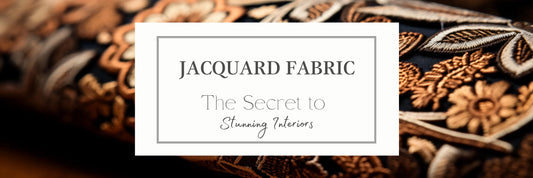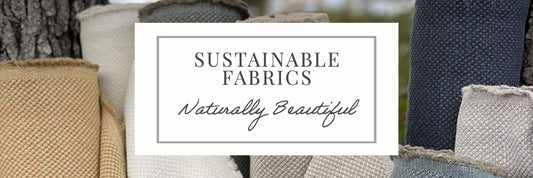Jacquard Fabric stands out in the world of fabrics, its unique patterns and rich history make it a top choice for upholstery and home fashion. In this guide, we'll focus on all things Jacquard Fabric. How you can identify Jacquard Fabric, what is it and how is it used in upholstery, home fashion and other applications. Whether you love design, want to update your living room, or are just curious about fabrics, this article will give you valuable insights into this timeless material.
What is Jacquard Fabric?
Jacquard fabric is named after Joseph Marie Jacquard, a French weaver who invented the Jacquard loom in 1804. This loom was a big deal. It used punch cards to control the weaving process, allowing complex patterns to be woven directly into the fabric.
The Jacquard loom changed the textile industry. Before it was invented, making detailed patterns in fabric was hard work, needing skilled workers to move the threads by hand. The Jacquard loom made this process automatic, making it possible to create complex designs more easily and consistently.
Today, Jacquard refers to any fabric woven using this method. The result is a fabric with intricate designs woven into it, not just printed on top. This makes Jacquard great for creating elegant and formal looks in upholstery and other home decor projects.
Key Characteristics for Jacquard Fabric
Jacquard fabric has several distinct features that make it special:
- Woven Patterns: The most striking feature of Jacquard is its woven-in patterns. These can range from simple shapes to complex floral designs.
- Texture: Jacquard fabrics often feel raised. The pattern is slightly higher than the background, giving the fabric depth you can feel.
- Weight: Jacquards tend to be heavier than many other fabrics. This makes it durable and a good choice for upholstery.
- Sheen: Many Jacquard fabrics have a slight shine. This adds to their formal appearance and can make them look striking in different lights.
- Versatility: Jacquard can be made from various fibers, including cotton, silk, wool, and synthetic materials like polyester.

Visual Identification Tips
Spotting Jacquard fabric isn't hard once you know what to look for. Here are some tips to help you identify Jacquard fabrics:
- Look for the Pattern: Jacquard patterns are woven into the fabric, not printed.
- Check the Texture: Run your hand over the fabric. Jacquard often has a slightly raised pattern you can feel.
- Observe the Sheen: Many Jacquard fabrics have a slight sheen that catches the light.
- Note the Weight: Jacquard is usually heavier than printed fabrics.
Common Types of Jacquard Fabrics
Several types of fabrics fall under the Jacquard umbrella. Here are some you're likely to encounter:
- Brocade: This heavy fabric features raised designs, often with a metallic sheen.
- Damask: Damask has a reversible pattern, usually in one color.
- Matelassé: This fabric mimics the look of quilting or embroidery.
- Tapestry: Featuring pictorial designs, tapestry Jacquard is popular for wall hangings and some upholstery.
- Cotton Jacquard: This versatile fabric combines the intricate patterns of Jacquard weaving with the comfort of cotton.

Practical Applications
Jacquard fabric shines in many areas of home fashion:
- Upholstery
- Drapery
- Bedding
- Table Linens
- Throw Pillows
- Wall Hangings
- Fashion
Caring for Jacquard Fabric
Proper care can significantly extend the life of your Jacquard fabrics. Here are some general tips:
- Regular Cleaning: Vacuum upholstered pieces regularly using a soft brush attachment to prevent dust buildup.
- Spot Cleaning: Address spills immediately. Blot, don't rub, to avoid damaging the fabric's texture.
- Professional Cleaning: For large pieces or stubborn stains, professional cleaning is often the safest option.
- Avoid Direct Sunlight: Prolonged exposure can fade the fabric's colors. Use window treatments to protect Jacquard upholstery.
- Follow Care Labels: Always check and follow the manufacturer's care instructions, as requirements can vary based on the specific fibers used.
Remember, different fibers may require different care. Cotton Jacquard might be machine washable, while silk Jacquard requires dry cleaning.
Conclusion
Jacquard fabric offers a unique blend of beauty, durability, and versatility. Its intricate patterns and rich texture make it a standout choice for upholstery and home fashion. From the formal elegance of a damask drapery to the cozy sophistication of a cotton Jacquard throw pillow, this fabric adds depth and interest to any space.
Understanding the characteristics and applications of Jacquard fabric empowers you to make informed decisions in your home decor projects. Whether you're reupholstering a cherished piece of furniture, selecting curtains for a formal living room, or even choosing fabric for a special occasion dress, your knowledge of Jacquard will serve you well.
Next time you're shopping for fabric, put your new knowledge to use. Look for those tell-tale signs of Jacquard: the woven-in patterns, the slight sheen, and the satisfying weight of the fabric. With this guide in hand, you're well-equipped to spot quality Jacquard and use it to elevate your home decor or wardrobe aesthetic.
Ready to begin exploring performance fabric? Browse our online options here.

Common Questions
Is Jacquard fabric expensive?
Jacquard can be pricier than some other fabrics due to its complex weaving process. However, its durability often makes it a good long-term investment.
How do I clean Jacquard fabric?
Cleaning methods vary based on the specific fibers used. Always check the care label. Many Jacquard fabrics used in upholstery are dry clean only.
Can Jacquard fabric be used outdoors?
Traditional Jacquard isn't suited for outdoor use. However, some manufacturers now produce outdoor Jacquard fabrics with added UV and moisture resistance.
Is Jacquard fabric always formal?
While Jacquard is often associated with formal designs, modern Jacquards come in a wide range of patterns, including casual and contemporary styles.
How durable is Jacquard fabric for upholstery?
Jacquard is generally very durable, especially when made with synthetic fibers like polyester. This makes it an excellent choice for upholstery in high-traffic areas.




